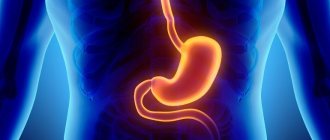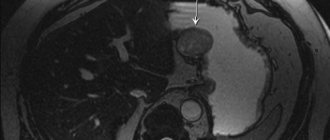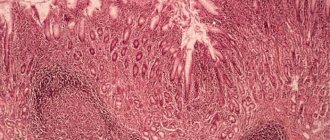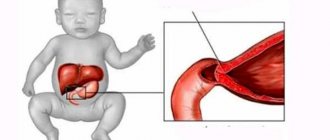Gastroenterological pathology occupies one of the leading places in the structure of diseases. The clinical picture of erosive lesions of the gastrointestinal tract is closely related to the morphological state of the mucous membrane and the presence of defects on its surface. Therefore, the main question that arises among patients is how to cure gastric erosion and what it is. A gastroenterologist will help solve the problem, diagnosing symptoms and prescribing medication.
Gastric erosion - what is it?
Pathological changes in the mucous membrane have its own histological features.
Gastric erosion is damage to organ tissue, which is characterized by the appearance of superficial ulcers without destruction of the muscle layer. Defects can be single or multiple. In 10% of people suffering from this disease, ulcerative elements are diagnosed in the lower third of the antrum and on the wall of the duodenum, causing bulbitis, which aggravates the course of the disease.
Types of gastric erosions
The erosive process can develop in several directions. There are various modifications of classifications by which pathology is divided. The authors offer these options.
- According to the type of occurrence of erosion, there are: primary - as an independently arising form;
- secondary - due to another disease;
- malignant - in the form of the initial stage of cancer.
- single - up to 3 lesions;
- acute - lasting from 10 days to 2 months;
- hemorrhagic;
The topographic location of gastric erosion is also determined:
- in the antrum;
- at the bottom of the organ;
- in the area of the pylorus.
Classification and forms
Depending on various parameters, many types of pathology are distinguished. For example, if the classification criterion is an etiological factor, it is customary to talk about such forms of the disease as:
- Independent, arising as a primary pathological process;
- Developing against the background of other diseases of the digestive system;
- Oncological, caused by the presence of malignant neoplasms in the stomach.
Based on their appearance, the following forms of erosion are distinguished:
- Flat (the surface of the affected area does not rise above the surface of healthy tissue, or rises slightly);
- Polypoid (erosion is a nodular compaction, clearly visible against the background of other tissues);
- Bleeding (the development of erosion is accompanied by the constant release of a small amount of blood). This form is characteristic of pathology in an advanced stage.
Depending on the symptoms and their severity, acute or chronic forms are distinguished. In an acute course, the signs of pathology are more intense; in a chronic course, they are erased; however, the danger of a chronic course lies in the increased risk of developing an ulcer.
Depending on the affected area, there are:
- Complete erosion of the stomach. Often with the development of this form, the gastric mucosa becomes inflamed. Swelling develops. Characteristic compactions form in the antrum of the organ;
- Superficial, in which only the outer layer of the epithelium is damaged. Erosion has a flat shape and various sizes;
- Hemorrhagic, in which the affected area consists of individual bright red bleeding elements.
Causes of gastric erosion
Signs of pathology appear suddenly or develop gradually. The causes of gastric erosion play an important role in the pathogenesis. These include:
- bacterial infection by Helicobacter pylori;
- low quality food;
- frequent intake of spicy, cold, hot foods, food additives and dyes;
- drug therapy over a long period of time, especially the use of antibacterial and non-steroidal anti-inflammatory drugs, drugs of the sulfonamide group;
- regular psycho-emotional stress, stressful situations;
- chronic concomitant diseases of the gastrointestinal tract, endocrine system;
- occupational hazard;
- bad habits - smoking, drinking alcohol in large doses;
- unfavorable heredity.
Attention! Identification of several risk factors at the same time increases the likelihood of erosion of the gastric mucosa.
Reasons for appearance
Erosion of the antrum of the stomach - what is it? This disease is caused by the proliferation and activity of the bacterium that lives in the stomach, Helicobacter pylori. It is the fact that antibodies to the virulence factors of this microorganism were detected during examination in almost 90% of patients suffering from gastropathy of various kinds, which allows us to speak with confidence about the etiological role of the pathogen.
become infected with Helicobacter pylori in a family without proper personal hygiene, or in closed groups with the same problems. Therefore, familial cases of the disease are very common. The following causative factors can aggravate and contribute to the course of the disease:
- any errors in nutrition or diet;
- long-term use of drugs that irritate the gastric mucosa;
- fasting or systematic overeating;
- smoking, drinking alcohol;
- systematic or permanent stress;
- metabolic diseases;
- tumor diseases of the gastrointestinal tract, both malignant and benign.
The predominance of spicy, salty, and sour foods in the menu will inevitably lead to the formation of acute erosion of the antrum of the stomach or other pathology of the digestive organ. These dishes cause the release of gastric juice with increased acidity.
Many medications, when taken orally, cause irritation of the mucous membrane and may have hemorrhagic complications. For example, non-steroidal anti-inflammatory drugs, corticosteroids, antiarrhythmic drugs. they must be taken under the cover of food, observing the time intervals and duration of course doses.
Uneven distribution of food during the day, fasting, and malnutrition lead to a disorder in the rhythmic formation of hydrochloric acid; it is constantly in the stomach and corrodes the mucous membrane. So much has been said and written about the dangers of smoking and alcohol that there is no need to repeat it and convince the reader of their danger. Nervous overload is accompanied by the release of stress and fear hormones, which depletes the body's enzyme system. The stomach suffers first.
Tumors and metabolic diseases affect the gastric mucosa both directly and indirectly. If a patient has diabetes mellitus, cirrhosis of the liver, pancreatitis, tumors of the intestines or other organs, then food cannot be properly digested and move through the gastrointestinal tract, which negatively affects the condition of the mucosa not only of the antrum, but of the entire digestive tract. For example, there is a systematic reflux and stagnation of bile in this section, which provokes irritation of the mucous membrane.
Symptoms of gastric erosion
The pathological process manifests itself in different ways, depending on the nature of the disease, location, and type of lesions.
In most cases, symptoms of gastric erosion in adults are represented by the following options:
- The presence of discomfort and pain in the upper half of the anterior abdominal wall, sometimes in the left hypochondrium. Characteristic signs of the syndrome are at night and “hunger” pain. In the presence of acute erosion, there is paroxysmal pain.
- Dyspeptic symptoms in the form of heartburn, belching, nausea, vomiting, unstable stool.
- Attachment of hemorrhagic syndrome with bleeding from erosions in the form of an admixture of “coffee grounds” in the vomit, dark brown stool.
- In chronic pathology, iron deficiency anemia occurs, nails become brittle, hair may fall out, and back pain may occur. Asthenia appears, which is characterized by decreased performance, weakness, and irritability.
Against the background of a long course of pathology, an exacerbation often occurs, which is characterized by a sudden onset and disruption of the patient’s condition.
Are stomach erosions dangerous?
If there are areas of modified mucous membrane, symptoms may not be detected for a long time. Therefore, patients are interested in why gastric erosion is dangerous and what consequences of the pathology arise. Under the influence of unfavorable factors, there is a possibility of degeneration of the morphological substrate, which manifests itself as complications or the formation of a malignant process.
Symptoms
The painful symptoms that patients complain about depend on the location of the erosion - if it is located in the body of the stomach, then the complaints will be pain in the hypochondrium; with damage to the antrum, the discomfort is localized in the center of the abdomen.
Pain in pathology is divided into 2 main groups:
- hemorrhagic;
- ulcerative.
Those suffering from erosion of the body of the stomach complain of:
- discomfort and pain after eating;
- sometimes pain occurs when there is no food in the stomach (hunger pain);
- nausea;
- belching air;
- constantly recurring attacks of heartburn;
- pain on the right under the ribs;
- attacks of hunger pain radiating in the spine.
Signs of gastric erosion, similar to gastritis or peptic ulcer, are observed in 4 out of 5 patients. Additional symptoms in older people will be pressure surges against the background of hunger pain, paroxysmal pain in the chest, yellowing of the skin, and severe fatigue.
The presence of bleeding and complaints of weakness will be observed in 1 person out of 5. Such a patient complains of:
- heartburn;
- black chair;
- constant weakness and anemia;
- low ability to work;
- vomiting with traces of blood.
Bleeding erosions are dangerous because subtle, minor, but constant bleeding causes anemia due to the constant loss of hemoglobin. The difference between bleeding erosions and superficial ones is the absence of pain - if with minor bleeding the patient complains of pain, then with large bleeding the pain practically disappears. This can be explained by the destruction by the pathological process, first of the endings of the nerve fibers approaching the mucosa, then of the blood vessels. If pathologies are noted over large areas, and during exacerbations massive bleeding and a sharp deterioration in condition are recorded, the patient should be taken to a doctor as quickly as possible.
Diagnostics
An examination for suspected pathology includes anamnesis, objective data and auxiliary studies. The specialist first clarifies the patient’s complaints and determines the possible causes of the disease. Then he orders an additional examination.
Endoscopic photo of multiple gastric erosions
Gastric erosion is diagnosed using the following methods:
- general clinical and biochemical tests of blood, urine and feces;
- esophagogastroduodenoscopy with biopsy from an erosive lesion;
- chromogastroscopy;
- intragastric pH-metry;
- detection of Helicobacter pylori by the activity of the enzyme urease;
- morphological study of mucosal biopsies in chronic patients;
- ultrasound method of examining the abdominal cavity.
Important! Ancillary activities help determine the diagnostic criteria with which the gastroenterologist makes the final diagnosis.
Gastric erosion: treatment
An integrated approach to disease treatment is the main factor for a successful outcome. Treatment of gastric erosion includes drugs and a regimen presented in the following table.
Table 1. Treatment of gastric erosion
| Drugs | Reception scheme | |
| 1. | Antibiotics:
| Up to 7-14 days |
| 2. | Antacids (Maalox, Gaviscon, phosphalugel) | Up to 10 days |
| 3. | Proton pump inhibitors (omeprazole) | Up to 10 days - in acute form, up to 8-12 weeks in chronic form |
| 4. | Histamine receptor blockers (ranitidine, famotidine) | Up to 10-14 days |
| 5. | Bismuth preparations (De-Nol) | Up to 4-8 weeks |
| 6. | Prostaglandins | Up to 4-8 weeks |
| 7. | Regenerative agents (Actovegin) | Up to 4-8 weeks |
Treatment of gastric erosion with medications differs in acute and chronic pathology. In the first case, therapy takes up to 2 weeks. In addition to the main regimen, short-course painkillers are included. With a long course of the disease, it takes from 4 to 8 weeks, in some cases longer.
Therapeutic measures for various defects have some differences, presented in Table 2.
Table 2. Symptoms and treatment of certain types of gastric erosions
| Type of erosion | Characteristic | Symptoms | How to treat |
| Acute erosions of the body of the stomach | Flat polymorphic defects with fibrinoid and hematinic plaque located in the antrum or fundus of the stomach | Signs of acute gastric erosion are sharply expressed due to the symptom in the form of pain in the upper abdomen, which is difficult to relieve with medications, often accompanied by hemorrhagic syndrome in the form of vomiting mixed with blood or melena | Acute erosion is treated with the following medications:
|
| Chronic gastric erosion | Mature or immature lesions with a halo of hyperemia, desquamation and tissue necrosis | Symptoms of chronic erosions are manifested by discomfort and pain of a less pronounced nature, there are signs of dyspeptic disorder | Treatment of the condition includes the use of:
|
| Multiple hemorrhagic erosions of the stomach | There are more than 4 lesions | Periodically there are signs of gastric bleeding and symptoms of melena | The solution to the problem of how to treat multiple hemorrhagic erosions lies in stopping the bleeding and restoring the mucous membrane with medications and laser therapy. The main groups of drugs are:
|
| Hemorrhagic erosions | Point hemorrhagic erosions of the stomach are characterized by the deposition of hematin and isolated hemorrhages, prone to the formation of ulcerative process and malignancy | Hemorrhagic single erosions of the body of the stomach rarely have an acute onset; a latent course of the pathology is noted with the formation of anemia and manifestations of asthenia; blood corpuscles are determined in stool tests | Treatment of hemorrhagic erosions consists of restoring the gastric mucosa and eliminating anemia |
| Hyperplastic erosion | Endoscopic and X-ray signs of the disease reveal immature elements with pronounced regenerative cell hyperplasia on the walls of the stomach; signs of hyperplastic erosion develop reversely in 30% of cases | The course of the disease is chronic with periodic exacerbation of symptoms due to the influence of unfavorable factors | Treatment of hyperplastic erosion of the stomach includes drugs that can be taken as for the chronic version. Treatment must be long-term, for 5-7 years. |
| Complete erosion | A chronic variant of the course in the form of raised areas of the mucous membrane of the full type with an umbilical depression in the center, similar to smallpox elements | Complete erosion of the prepyloric part of the stomach is characterized by a chronic course with periodic exacerbation of symptoms and a high probability of the formation of ulcerative elements | Treatment according to the chronic erosion protocol |
Prognosis: what will happen if left untreated?
Expert opinion
Irina Vasilievna
Practicing gastroenterologist
In the absence of gastric bleeding and timely treatment, the prognosis for recovery in patients diagnosed with erosive gastritis is quite favorable . If the disease is diagnosed for the first time, and treatment measures are carried out in accordance with the therapeutic plan, a complete cure can be achieved even on an outpatient basis.
With delayed diagnosis, the acute form of the disease becomes chronic , which is difficult to treat and often relapses even after surgery.
On our website: Gastritis of the duodenum: symptoms and treatment
Nutrition
One of the main stages of treatment is a special diet. Nutrition for gastric erosion must be of high quality and varied in order to provide the body with microelements, vitamins and energy components. The frequency of meals increases to 5-6 times a day. The temperature of the food should be comfortable to avoid irritation of the mucous membranes.
Diet for erosive gastritis with a sample menu for a week
What can you eat if you have stomach erosion and what can’t you eat?
The diet must meet the requirements presented in Table 3.
Table 3. Nutrition for gastric erosion
| You can eat | Can't eat |
| I eat it boiled, steamed, stewed | Food with a rough texture |
| Lean meat and fish - chicken, beef, rabbit, pike perch | Fatty meat with elements of connective tissue and skin; offal |
| Stewed vegetables (pumpkin, beets), neutral-tasting fruits - apples, pears, peaches | Raw plant foods, sour vegetables and fruits, citrus fruits, walnuts, seeds |
| You can drink jelly, sweet fruit infusions, weak tea | Juices, fresh drinks, sparkling drinks, coffee, cocoa |
| Porridge - buckwheat, rice, oatmeal | Yeast baked goods, products made from low-grade flour |
| Baked goods made from premium flour, vegetable oil | Butter, margarine |
| Honey, marshmallow | Chocolate |
| Milk porridges, puddings, low-sour cottage cheese | Fermented milk products, kefir |
| Boiled eggs, omelet | Legumes, celery, turnips, radishes |
| Alcoholic drinks, including beer |
Stomach erosion: treatment with folk remedies
Along with drug therapy, alternative methods are used. Many patients are interested in how to treat gastric erosion with folk remedies. The following are the most effective natural products that can be used at home. Recipes from them are presented in the table.
Table 4. The most effective folk remedies for treating gastric erosion
| Potato juice | The juice obtained by rubbing 2-3 potato tubers is diluted with a small amount of water. Drink up to 3 times a day half an hour before meals for 14 days |
| Sea buckthorn oil | Consume warm, 5 ml 2-3 times a day before meals. |
| Flax seed | Boil one tablespoon of seeds for 5 minutes. They insist for two hours. Take the mucous mass 3-4 times a day before meals |
| Aloe honey | Aloe juice is mixed with honey. Take daily in the morning on an empty stomach for a month |
| Calamus root | Pour one teaspoon of the mixture into a glass of boiling water and cook for another 15 minutes over low heat. Drink 50 ml of the decoction before meals for 14 days. |
Treatment of rectal erosions
Rectal erosions are associated with ulcerative colitis. When the diagnosis is confirmed, specific treatment is carried out: anti-inflammatory and immunosuppressive (inhibiting immune reactions).
Anti-inflammatory therapy includes:
- Drugs derivatives of aminosalicylic acid , which have an anti-inflammatory effect and inhibit the synthesis of prostaglandins. This group of drugs either contains only aminosalicylic acid or a combination with sulfonamides Mesalazine , Balsalazide , Sulfasalazine , Olsalazine , Mesalamine , Salofalk . The drugs are taken orally, and if only the rectum is affected, they are used topically in suppositories or in the form of enemas (for example, Salofalk). In patients with a mild course, monotherapy with only these drugs is possible. Regular use of Salofalk reduces the risk of cancer in patients with ulcerative colitis.
- In severe and widespread forms, as well as when treatment with aminosalicylates is effective, treatment is supplemented with corticosteroids. In patients who have a long history of this disease and have already had experience with long-term corticosteroid therapy, treatment with 5-ASA is ineffective.
- Metronidazole . Adding it to anti-inflammatory drug therapy increases the effectiveness of treatment. The use of sucralfate in the rectum also has a positive effect on the dynamics of the erosive process.
- Corticosteroids. They are most effective in acute forms and in any localization of the process. Prednisolone is prescribed orally at a dose of 1-2 mg per kg of body weight per day. The dose is gradually reduced and discontinued over 3-4 months. If the rectum is affected, glucocorticoids are used in the form of enemas ( Budesonide in enemas) or rectal drips with hydrocortisone .
If long-term steroid therapy does not lead to remission, treatment uses immunosuppressants that suppress the activity of predominantly T-lymphocytes. Azathioprine ( Azathioprine , Imuran ) or its Mercaptopurine . Dose for adults: 2-3 mg per kg of body weight per day. Drugs in this group put the disease into remission.
In case of bacterial infections, ciprofloxacin is used. If there is no effect from conservative treatment, or if complications occur, surgical treatment is performed.
Prognosis for treatment and recovery
Symptoms of the disease may be mild, but increase over time. With a long-term course of the pathological condition, patients are concerned about the question of whether gastric erosion can be cured forever. Complete restoration of the mucous membrane occurs with timely intervention in the acute phase of the process. The positive result of treatment of the chronic form depends on the morphological type of erosive defects and the degree of influence of provoking factors.











